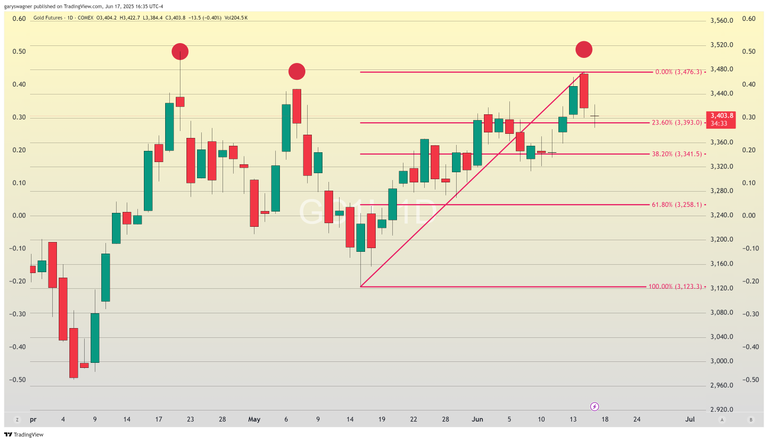Gold prices retreated for the second consecutive session on Tuesday, declining despite persistent geopolitical tensions in the Middle East that would typically drive investors toward safe-haven assets. The precious metal's pullback came as dollar strength overwhelmed the traditional flight-to-quality dynamics that have historically supported gold during periods of international uncertainty.

After reaching record closing levels on Friday, gold futures for the most active August contract settled at $3,403.30 per ounce, representing a 0.43% decline or $14.40 drop as of 4:15 PM ET. The retreat occurred even as the Israel-Iran conflict continues to escalate, with no clear resolution on the horizon. Typically, such geopolitical instability would provide substantial support for gold prices as investors seek refuge from market volatility.

The primary catalyst for gold's decline was the remarkable strength of the U.S. dollar, which surged 0.74% to close at 98.879 on the dollar index. This currency strength proved more influential than the ongoing Middle Eastern tensions, demonstrating the complex interplay between safe-haven demand and currency dynamics in precious metals markets. The differential between the dollar's 0.74% gain and gold's 0.43% decline suggests that while some speculative buying supported gold prices, it was insufficient to overcome the headwind created by dollar appreciation.
Market participants had been positioning for continued gold strength following escalating Middle Eastern tensions, with prices approaching the record high of $3,509.90 per ounce established in April. However, sentiment shifted when Iran indicated openness to de-escalation discussions, prompting traders to reduce their bullish gold positions. This development highlights the sensitivity of precious metals markets to diplomatic developments, even amid ongoing hostilities.
Peter Cardillo of Spartan Capital Securities attributed Monday's decline to profit-taking triggered by the dollar's rebound, while emphasizing that the fundamental drivers supporting gold remain intact. "I see the dollar's rebound causing the profit taking today, but the fundamentals of Central Bank buying remain unchanged," Cardillo noted. His analysis suggests that the current weakness represents a temporary technical correction rather than a fundamental shift in gold's outlook.
Despite near-term volatility, long-term prospects for gold remain robust. Cardillo maintains that gold remains investors preferred safe-haven asset, projecting potential price appreciation to $5,000 per troy ounce over the longer term. This bullish outlook reflects ongoing central bank accumulation and persistent global economic uncertainties.
The dollar's strength emerged paradoxically from disappointing economic data, as government reports showed U.S. retail sales falling more than anticipated last month. This decline represents the latest indication of economic deceleration, following weaker-than-expected inflation data released the previous week. Such economic softening typically weighs on currency values, making the dollar's rally particularly noteworthy.
Market attention now turns to the Federal Reserve's two-day policy meeting, with the July FOMC gathering commanding particular focus. The CME's FedWatch tool indicates a 99.8% probability that rates will remain unchanged this month, effectively eliminating expectations for immediate monetary easing. However, traders will scrutinize the Fed's updated "dot plot" projections, which reveal officials' anticipated future rate trajectory and provide crucial guidance for both currency and precious metals markets moving forward.
For those who wish to learn more about our service, please Click Here
Wishing you as always, good trading

